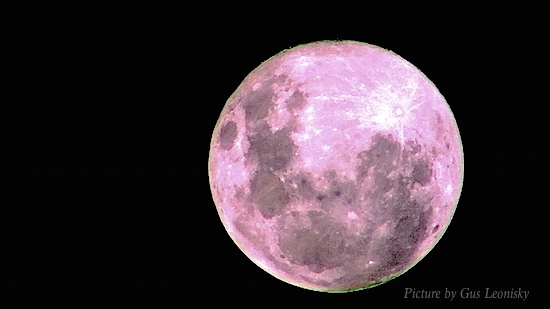Search
Recent comments
- no invasion of europe....
38 min 53 sec ago - dictator don....
1 hour 24 sec ago - not only trump....
1 hour 10 min ago - prearranged deal....
1 hour 27 min ago - end of biolabs?....
4 hours 4 min ago - atrocities.....
4 hours 12 min ago - but....
5 hours 1 min ago - banditry....
6 hours 9 min ago - censoring...
7 hours 28 min ago - and a pike....
7 hours 34 min ago
Democracy Links
Member's Off-site Blogs
a pink moon...
 pink moon
pink moon
- By Gus Leonisky at 28 Apr 2021 - 5:30am
- Gus Leonisky's blog
- Login or register to post comments
not really pink...
I have enhanced the colour in the picture above. It's what we do. On automatic exposure, what the camera/picture seems to show is just a bright white moon in the middle of a black sky. But this isn't what is to be seen. The camera collects more than just the white of the moon. With a tad of filtering, which can be done when taking the picture on manual time exposure, one can see that the image captured more details that could not be "seen" in the first instance. This was shot full frame (no cropping) with a x52 telelens. Same with the picture below, with the moon seen through tree branches...
The brightest and largest object in our night sky, the Moon makes Earth a more livable planet by moderating our home planet's wobble on its axis, leading to a relatively stable climate. It also causes tides, creating a rhythm that has guided humans for thousands of years. The Moon was likely formed after a Mars-sized body collided with Earth.
Earth's Moon is the fifth largest of the 190+ moons orbiting planets in our solar system.
Earth's only natural satellite is simply called "the Moon" because people didn't know other moons existed until Galileo Galilei discovered four moons orbiting Jupiter in 1610.
NASA currently has three robotic spacecraft exploring the Moon — Lunar Reconnaissance Orbiter and the twin ARTEMIS spacecraft (not to be confused with NASA's new Artemis program to send astronauts back to the Moon).
Read more:
https://solarsystem.nasa.gov/moons/earths-moon/overview/
FREE JULIAN ASSANGE NOW !!!!!!!!
If you look up later tonight, you'll see a beautiful full moon as it makes its closest approach to Earth this month — aka a supermoon.
In North America, the April full moon is known as a "pink" moon.
It's not actually pink in colour — according to folklore, it's named after the first pink flower of the season.
While the Moon will look full all night, in astronomy the full moon happens at a specific point in time when the Moon is directly opposite the Sun (syzygy).
This year, the full moon falls just after midday today in all states except Western Australia, where it falls at 11:00am.
Then, 12 hours later, it comes within 357,378 kilometres from Earth (perigee).
Read more:
https://www.abc.net.au/news/science/2021-04-27/super-pink-full-moon-to-shine-across-australia-perigee-syzygy/100066644
moon waves...
When the moon is high in the sky, it creates bulges in the planet’s atmosphere that creates imperceptible changes in the amount of rain that falls below.
New University of Washington research to be published in Geophysical Research Letters shows that the lunar forces affect the amount of rain – though very slightly.
“As far as I know, this is the first study to convincingly connect the tidal force of the moon with rainfall,” said corresponding author Tsubasa Kohyama, a UW doctoral student in atmospheric sciences.
Kohyama was studying atmospheric waves when he noticed a slight oscillation in the air pressure. He and co-author John (Michael) Wallace, a UW professor of atmospheric sciences, spent two years tracking down the phenomenon.
Air pressure changes linked to the position of the moon was first detected in 1847, and temperature in 1932, in ground-based observations. An earlier paper by the UW researchers used a global grid of data to confirm that air pressure on the surface definitely varies with the position of the moon.
“When the moon is overhead or underfoot, the air pressure is higher,” Kohyama said.
Their new paper is the first to show that the moon’s gravitational tug also puts a slight damper on the rain.
When the moon is overhead, its gravity causes Earth’s atmosphere to bulge toward it, so the pressure or weight of the atmosphere on that side of the planet goes up. Higher pressure increases the temperature of air parcels below. Since warmer air can hold more moisture, the same air parcels are now farther from their moisture capacity.
“It’s like the container becomes larger at higher pressure,” Kohyama said. The relative humidity affects rain, he said, because “lower humidity is less favorable for precipitation.”
Kohyama and Wallace used 15 years of data collected by NASA and the Japan Aerospace Exploration Agency’s Tropical Rainfall Measuring Mission satellite from 1998 to 2012 to show that the rain is indeed slightly lighter when the moon is high. The change is only about 1 percent of the total rainfall variation, though, so not enough to affect other aspects of the weather or for people to notice the difference.
“No one should carry an umbrella just because the moon is rising,” Kohyama said.
Instead, this effect could be used to test climate models, he said, to check if their physics is good enough to reproduce how the pull of the moon eventually leads to less rain.
Wallace plans to continue exploring the topic to see whether certain categories of rain, like heavy downpours, are more susceptible to the position of the moon, and whether the frequency of rainstorms shows any lunar connection.
The research was funded by the National Science Foundation, the Takenaka Ikueikai Scholarship Society, and the Iizuka Takeshi Scholarship Foundation.
Read more:
https://www.washington.edu/news/2016/01/29/phases-of-the-moon-affect-amount-of-rainfall/#
Read from top
FREE JULIAN ASSANGE NOW !
blue moon...